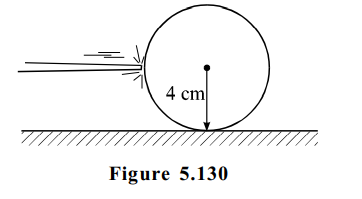Q.
A uniform ring placed on a rough horizontal surface is given a sharp impulse as shown in the figure-$5.130$. As a consequence, it acquires a linear velocity of $2 m / s$. If coefficient of friction between the ring and the horizontal surface is $0.4$ :
System of Particles and Rotational Motion
Report Error
Solution:
$v_{0}=2 m / s$
$\mu =0.4 $
$m v_{0}-f t =m v\,\,\,...(1)$
where $v$ is velocity acquired by ring when slipping stops.
$0+f R t=I \frac{v}{R}\,\,\,...(2)$
Dividing (1) by (2), we get,
$\frac{m v_{0}-f t}{f R t}=\frac{m v}{m R^{2} \cdot\left(\frac{v}{R}\right)}$
$ f R t =m v_{0} R-f R t $
$ \mu m g R t =m v_{0} R-\mu m g+R \,\,\,(\because f=\mu m g) $
$ 2 \mu g t =v_{0} $
$t=\frac{v_{0}}{2 \mu g}=\frac{2}{2 \times 0.4 \times 10}=0.25 s$
Thus, ring will start pure rolling after $0.25 s$
From (1),
$m v_{0}-f t =m v$
$m v_{0}-\mu m g t =m v $
$v =v_{0}-\mu g t=2-(0.4)(10)(0.25)$
$v =1 \,m / s$
When ring will start pure rolling, its velocity is $1 \,m / s$.
From $0.25$ s to $0.5$ s, i.e.,
$t =0.5-0.25=0.25\, s ,$
$v^{\prime} =v_{0}-\mu g t$
$v^{\prime} =2-1=1 \,m / s$
Questions from System of Particles and Rotational Motion
Physics Most Viewed Questions
1. If $E$ and $G$ respectively denote energy and gravitational constant, then $\frac{ E }{ G }$ has the dimensions of:
NEET 2021
Physical World, Units and Measurements
2. The de Broglie wavelength of an electron moving with kinetic energy of $144 \,eV$ is nearly
NEET 2020
Dual Nature of Radiation and Matter
3. A car starts from rest and accelerates at $5\, m / s ^{2}$ At $t=4\, s$, a ball is dropped out of a window by a person sitting in the car. What is the velocity and acceleration of the ball at $t =6\, s$ ? (Take $\left. g =10\, m / s ^{2}\right)$
NEET 2021
Motion in a Straight Line
Latest Updates
- JEE Main 2023 February 25th Shift 1 Morning
- JEE Main 2023 February 25th Shift 2 Evening
- JEE Main 2023 January 31st Shift 1 Morning
- JEE Main 2023 January 31st Shift 2 Evening
- JEE Main 2023 January 30th Shift 1 Morning
- JEE Main 2023 January 30th Shift 2 Evening
- JEE Main 2023 January 25th Shift 1 Morning
- JEE Main 2023 January 25th Shift 2 Evening
- JEE Main 2023 January 24th Shift 1 Morning
- JEE Main 2023 January 24th Shift 2 Evening
- JEE Main 2023 February 1st Shift 1 Morning
- JEE Main 2023 February 1st Shift 2 Evening
- JEE Main 2022 July 25th Shift 1 Morning
- JEE Main 2022 July 25th Shift 2 Evening
- JEE Main 2022 July 26th Shift 1 Morning
- JEE Main 2022 July 28th Shift 1 Morning
- JEE Advanced 2022 Paper 2
- JEE Advanced 2022 Paper 1
- JEE Advanced 2021 Paper 2
- JEE Advanced 2021 Paper 1
- JEE Advanced 2020 Paper 2
- JEE Advanced 2020 Paper 1
- NEET 2022 Physics Answer Key
- NEET 2022 Chemistry Answer Key
- NEET 2022 Botany Biology Answer Key
- NEET 2022 Zoology Biology Answer Key
- NEET Rank Predictor 2023